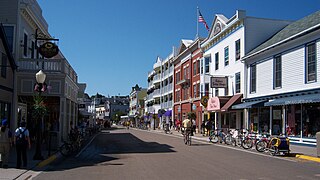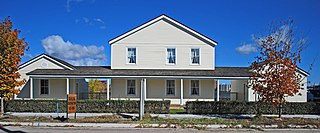
Mackinac Island is an island and resort area, covering 4.35 square miles (11.3 km2) in land area, in the U.S. state of Michigan. The name of the island in Odawa is Michilimackinac and "Mitchimakinak" in Ojibwemowin meaning "Great Turtle". It is located in Lake Huron, at the eastern end of the Straits of Mackinac, between the state's Upper and Lower Peninsulas. The island was long home to an Odawa settlement and previous indigenous cultures before European colonization began in the 17th century. It was a strategic center of the fur trade around the Great Lakes. Based on a former trading post, Fort Mackinac was constructed on the island by the British during the American Revolutionary War. It was the site of two battles during the War of 1812 before the northern border was settled and the US gained this island in its territory.

Mackinac County is a county in the Upper Peninsula of the U.S. state of Michigan. As of the 2020 census, the population was 10,834. The county seat is St. Ignace. Formerly known as Michilimackinac County, in 1818 it was one of the first counties of the Michigan Territory, as it had long been a center of French and British colonial fur trading, a Catholic church and Protestant mission, and associated settlement.

Mackinac Island is a city in Mackinac County in the U.S. state of Michigan. As of the 2020 census, the city had a population of 583.

Mackinaw City is a village at the northernmost point of the Lower Peninsula of Michigan. Divided between Cheboygan and Emmet counties, Mackinaw City is the located at the southern end of the Mackinac Bridge, which carries Interstate 75 over the Straits of Mackinac to the Upper Peninsula. Mackinaw City, along with St. Ignace, serves as an access point to Mackinac Island. For these reasons, Mackinaw City is considered one of Michigan's most popular tourist attractions.

Fort Mackinac is a former British and American military outpost garrisoned from the late 18th century to the late 19th century in the city of Mackinac Island, Michigan, on Mackinac Island. The British built the fort during the American Revolutionary War to control the strategic Straits of Mackinac between Lake Michigan and Lake Huron, and by extension the fur trade on the Great Lakes. The British did not relinquish the fort until thirteen years after the end of the American Revolutionary War. Fort Mackinac later became the scene of two strategic battles for control of the Great Lakes during the War of 1812. During most of the 19th century, it served as an outpost of the United States Army. Closed in 1895, the fort has been adapted as a museum on the grounds of Mackinac Island State Park.

Fort Michilimackinac was an 18th-century French, and later British, fort and trading post at the Straits of Mackinac; it was built on the northern tip of the lower peninsula of the present-day state of Michigan in the United States. Built around 1715, and abandoned in 1783, it was located along the Straits, which connect Lake Huron and Lake Michigan of the Great Lakes of North America.

Mackinac Island State Park is a state park located on Mackinac Island in the U.S. state of Michigan. A Lake Huron island, it is near the Straits of Mackinac. The island park encompasses 1,800 acres (7.3 km2), which is approximately 80% of the island's total area. The park is also within the boundaries of the city of Mackinac Island and has permanent residents within its boundaries. M-185 circles the perimeter of the park as the only motorless highway in the state due to the island's ban of automobiles. The park is governed by the Michigan Department of Natural Resources and the Mackinac Island State Park Commission. On July 15, 2009, the park celebrated its 20 millionth visitor.

Northern Michigan, also known as Northern Lower Michigan, is a region of the U.S. state of Michigan. A popular tourist destination, it is home to several small- to medium-sized cities, extensive state and national forests, lakes and rivers, and a large portion of Great Lakes shoreline. The region has a significant seasonal population much like other regions that depend on tourism as their main industry. Northern Lower Michigan is distinct from the more northerly Upper Peninsula and Isle Royale, which are also located in "northern" Michigan. In the northernmost 21 counties in the Lower Peninsula of Michigan, the total population of the region is 506,658 people.

Historic Mill Creek Discovery Park, formerly known as Historic Mill Creek State Park is a state park, nature preserve, and historic site in the United States state of Michigan. It is run by Mackinac State Historic Parks, the operating arm of the Mackinac Island State Park. 625 acres (2.5 km2) in size, the park is located 5 miles (8 km) southeast of Mackinaw City, Michigan on U.S. Highway 23.

The Richard and Jane Manoogian Mackinac Art Museum is an art museum located in the historic Indian Dormitory building on Mackinac Island, Michigan. The museum's exhibits feature art inspired by Mackinac Island, including historic painting and maps, photographs from the mid-19th to the mid-20th century, Native American art and beaded garments, and contemporary art and photography from area artists.

Madeline Island is an island in Lake Superior. Now part of Ashland County, Wisconsin, it has long been a spiritual center of the Lake Superior Chippewa. Although the largest of the Apostle Islands, it is not included in the Apostle Islands National Lakeshore. It is the only island in the Apostle Island chain open to commercial development and private ownership.

Magdelaine La Framboise (1780–1846), born Marguerite-Magdelaine Marcot, was one of the most successful fur traders in the Northwest Territory of the United States, in the area of present-day western Michigan. Of mixed Odawa and French descent, she was fluent in the Odawa, French, English and Ojibwe languages of the region, and partnered with her husband. After he was murdered in 1806, she successfully managed her fur trade business for more than a decade, even against the competition of John Jacob Astor. After retiring from the trade, she built a fine home on Mackinac Island.

The Mission House, on Mackinac Island, is a historic structure owned by the state of Michigan. Built in 1825, it is listed on the National Register of Historic Places and is operated as part of the Mackinac Island State Park. The Mission House is a wood-frame structure covered in clapboard siding and constructed in a U shape. The center section is three stories, and the flanking wings are two stories. The front facade has a single-story porch covering the entrance in the center.

The St. Ignace Mission is located in a municipal park known as Marquette Mission Park. It was the site of a mission established by Jesuit priest, Father Jacques Marquette, and the site of his grave in 1677. A second mission was established at a different site in 1837, and the chapel was moved here in 1954. The second mission chapel is the oldest Catholic church in Michigan and Wisconsin. The St. Ignace Mission was designated a Michigan State Historic Site in 1956, and was declared a U.S. National Historic Landmarks in 1960, one of the earliest sites recognized. The mission chapel serves as the Museum of Ojibwa Culture.

Elmwood, also known as the Henry Rowe Schoolcraft House, the Schoolcraft House or the Indian Agency, is a frame house located at 435 East Water Street in Sault Ste. Marie, Michigan. It was designated a Michigan State Historic Site in 1956 and listed on the National Register of Historic Places in 1974.

The John Johnston House is a private house located at 415 Water Street in Sault Ste. Marie, Michigan. It was listed on the National Register of Historic Places in 1970 and designated a Michigan State Historic Site in 1958.

The Robert Stuart House, also known as the Agent's House or Agency House, is a building located at 34 Market Street on Mackinac Island, Michigan. It was listed on the National Register of Historic Places in 1971 and designated a Michigan State Historic Site in 1965.

Sainte Anne Church is a Roman Catholic church located in the city of Mackinac Island in the U.S. state of Michigan.

Mission Point is located on the southeast side of Mackinac Island, Michigan. It is approximately 21 acres (8.5 ha) in size between Robinson's Folly and the jetty terminating near Franks Street. The Island has a history of documented European development beginning with French Jesuit missionaries landing at the point in 1634, less than two decades after the Pilgrims landed at Plymouth Rock on the East Coast of North America.
Agatha de LaVigne Biddle (1797–1873) was a woman of Odawa and French heritage, who primarily identified with her Odawa kin. She resided on Mackinac Island during the fur trade era and after. She acted as a partner with her husband in running their fur trade business, and Biddle was known as a shrewd businesswoman and her kinship connections were an integral part of the Biddle business. She was pivotal in the negotiations of the 1855 Treaty of Detroit where she used her relationships with local Indigenous peoples and settlers to negotiate on behalf of the Odawa peoples. Biddle was also renowned for her charity, and the aid she provided to her community, including needy children. The home she shared with her husband, independent fur trader Edward Biddle, known as Biddle House, still stands on Mackinac Island and was the site of many local gatherings. Agatha Biddle will be inducted into the Michigan Women's Hall of Fame on October 18, 2018.























